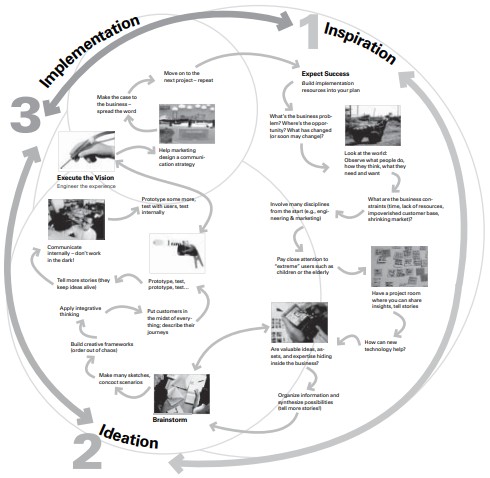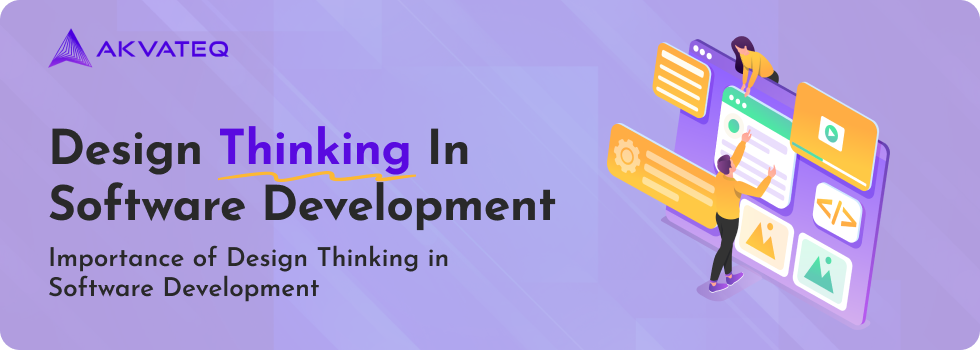Design thinking and a user-centric approach are ways of solving problems by using creative and practical methods. It involves both thinking and doing—using strategies and techniques to understand problems and create solutions.
It also includes the knowledge we have about how people think and make decisions when solving design challenges. The goal of design thinking is to find solutions that are useful, effective, and meet people’s needs.
Design thinking in software development is like creating a blueprint for your vision. You visualize an idea and try different ways to make it useful. You can improve it step by step. The goal is to create software that is not only useful but also easy to use for the end user. The software focuses on the user’s mind — understanding their needs, solving their problems, and improving their experience through smooth and intuitive navigation.
As a UI/UX design expert, I know how design thinking transforms software development. It’s not just about making things look perfect (although important), but also understanding the people who will use your software and crafting solutions that truly solve their problems.
get in touch to discuss your project
Why Should We Care About Design Thinking in Software Development?
Consider you’re building a new app for ordering food. It is not like that You just throw some code together and hope it works perfectly. If people find it confusing? and if they can’t find what they’re looking for? They’ll probably delete the app and go somewhere else. This is why always the end user keeps in mind while designing the software flow.
Design thinking helps us avoid pitfalls in the end software product. It’s a structural approach that puts the user at the center of the process. It’s like having a road map for creating software that people actually want to use. It’s about minimizing the failures and maximizing success.
The Five Stages of Design Thinking for Software Development
Design thinking typically involves five stages: Empathize, Define, Ideate, Prototype, and Test. Let’s explore each one:
Empathize: Understanding Your Users
This step is all about understanding your customers—who they are, what they need, and what problems they face. Think of it like detective work. You can interview users, see how they use similar software or create personas that represent your ideal customers. The goal is to see things from their perspective, understand their pain points, and find out what really matters to them. You can also use empathy maps to see what customers think, feel, say, and do. For example, if you’re building an app for gardeners, you may find that they struggle to identify plant diseases. This deep understanding becomes the foundation of your entire design process.
Define: Pinpointing the Problem
After gathering all your information, the next step is to clearly define the problem you want to solve. This goes beyond simply saying, “Users need a food ordering app.” You need to dig deeper.
For example, the real problem might be:
- Users can’t find healthy food options easily.
- Existing apps are too expensive.
- Delivery times are too slow.
A clear problem statement acts like a compass, guiding your team toward the right solution. For example:
“Our users struggle to find affordable, healthy meal options that can be delivered within 30 minutes.”
This focused definition helps you:
- Build something users truly need.
- Prioritize important features.
- Save time by staying on track during development.
Ideate: Brainstorming Solutions
Now comes the fun part: brainstorming! This is where you and your team get more creative and find different ways to solve the problem through software. At this stage, you are still in the process of designing, just let your creativity flow.
Encourage everyone on the team to share their ideas, even if they are designers. You can use techniques such as:
- Mind mapping: Connecting ideas visually around a central topic.
- Sketching: Drawing rough ideas to explore solutions.
- Role-playing: Acting out as an end user to find new perspectives
The goal is to generate as many ideas as possible. For example, you could try the “Crazy 8’s” method — where each person quickly sketches eight ideas in eight minutes.
Remember: At this stage, quantity is more important than perfection! The more ideas you have, the better your chances of finding a good solution for your software.
Prototype: Bringing Ideas to Life
Once you have a number of ideas, it’s time to create prototypes, it is simplified versions of your software. A prototype doesn’t have to be perfect. It needs to be clear enough to test with users and get feedback for improving the product.
get in touch to discuss your project
Prototypes can be:
- Paper sketches: Quick, hand-drawn screens.
- Clickable wireframes: Simple digital mockups to show user flow.
- Basic working models: Simple versions of the software with limited features.
The prototype may not have every detail, but it shows the overall structure and how everything fits together.
You can start with low-fidelity prototypes, such as paper sketches or sticky notes, to explore ideas quickly. Later, use design software to create a high-fidelity prototype that looks and feels like the final product. You can even create a product with minimum code and without full flash functionality.
The goal is to make your ideas in reality, test them with users, and gather feedback to improve.
Test: Getting User Feedback
Now it’s time to test your prototype with real users. Let them try it, watch how they use it, and ask for their feedback.
Pay attention to:
- What they like: What features are helpful or easy to use?
- What confuses them: Where do they get stuck or frustrated?
This step helps you learn what works and what doesn’t. Be ready to make changes and improve your design based on their feedback.
A good way to test is through usability testing sessions—where you:
- Observe users interacting with your prototype.
- Ask them to find bugs and share their thoughts as they use it.
Showing your low-functioning model to a random user and based on their opinion helps you refine your design until it’s truly user-friendly in both terms of UI and UX.
Benefits of Design Thinking for Software Development
Incorporating design thinking into software development has several advantages:
- Enhanced User Experience (UX): By focusing on the user, you create software that’s intuitive, enjoyable, and meets their needs. This leads to higher user satisfaction and adoption rates.
- Boosts Innovation: Design thinking encourages creative problem-solving and helps you explore new ideas. It fosters a culture of experimentation and learning.
- Reduced Risk: By testing prototypes early and often, you can identify and fix problems before they become major roadblocks. This saves time and money in the long run.
- Collaborative Environment: Design thinking encourages teamwork and communication, bringing different perspectives to the table. It breaks down silos and fosters a shared understanding of the user.
- Future-Ready Designs: By understanding user needs and trends, you can create software that’s not just relevant today, but also adaptable to future changes. This ensures your software remains competitive and valuable.
Design Thinking and Agile Methodology: A Powerful Combination
Design thinking and agile development always work well together, as they both focus on improving the product step-by-step with user feedback.
Design thinking helps you understand user needs and decide what to build and why it’s important. Agile, on the other hand, helps you build it in small discrete steps and work on continuous updates to improve it.
In Agile, you build software in short cycles called sprints, gathering feedback and making improvements along the way. This fits perfectly with design thinking, which encourages testing ideas by learning from users and adjusting the design based on feedback.
Together, design thinking and agile create a perfect process for building high-quality software product development that truly meets user needs in all aspects.
The Human Touch in a Digital World
When building the product, it’s easy to focus on technology and forget about the end users who are going to use it. Design thinking reminds us that software is made for people.
By putting the user at the center of the process, we can build software that is not only useful but equipped with a good interface and UX. It’s about creating experiences that:
- Solve real problems
- Make users’ lives easier
- Boost productivity
- Saving cost
Good software isn’t just about features—it’s about the easiness of work.
Beyond the Code: The Broader Impact
Design thinking isn’t just for software development. It can solve problems in many other fields, such as education, healthcare, or business. It’s a powerful way to tackle complex challenges and create solutions for these challenges that truly help people.
For example:
- In healthcare, design thinking can improve the patient experience in hospitals.
- In education, it can help redesign classrooms to make learning more engaging.
No matter the industry, DT helps us understand people’s needs and create solutions that make things user-friendly.
The Importance of Iteration
The DT process is not linear. It’s iterative, meaning you can go back and forth between different stages as you learn more about the end-user and the solution you provide. While testing a prototype you may realize you need to redefine the problem. You can also brainstorm new ideas after getting feedback on your initial design.
This iterative approach allows you to continuously improve your software to meet user needs. It’s about embracing the learning process and always being open to change.
Measuring the Success of Design Thinking
How do you know if design thinking is working? You can measure its success in several ways:
- User satisfaction: Are users happy with the software?
- Adoption rates: How many people are using it regularly?
- Engagement: Are users interacting with the features often?
You can also gather feedback through user research, such as interviews or surveys, to understand what users like and what needs improvement.
In the end, the best measure of success is the impact on users.
- Does the software solve their problems?
- Does it make their lives easier or better?
If the answer is yes, then your design thinking approach is working!
Companies Known for User-Centric Approach
Several companies have revolutionized software development by prioritizing user experience through design thinking:
- Google: Google uses something called “design sprints” to quickly test and improve how users experience their products. This helps make them products that are easy and intuitive to use like Gmail.
- Apple: They Focus on making everything smooth and user-friendly with people in mind and then and then design the products.
- IDEO: They are pioneer in design thinking, Ideo helps businesses to create innovative, and user-friendly digital solutions.
- Microsoft: Microsoft products are pretty much easier to use, this is why their products are still number one in usage. They understand the importance of design thinking.
- IBM: Uses a method called “Enterprise Design Thinking” to make sure their software actually solves real problems for users, especially when it comes to AI-powered apps.
Methodologies & Frameworks for User-Centric Software Development
- Design Thinking: This method is about understanding people’s needs and coming up with creative solutions that truly help the end user.
- Agile Development: Instead of building everything at once, the agile method allows the teams to work in small steps, and then constantly improve the product based on feedback.
- Lean UX: This is about testing ideas quickly and focusing on what matters. It helps avoid wasting time on things users don’t need or want.
- SCRUM: A teamwork-friendly way to manage projects. In scrum, both developers and designers work closely together in short and focused bursts to deliver results faster and adapt to changes.
- Kanban: It is a visual workflow management that helps teams optimize software development processes.
Technologies & Tools for User-Centered Design
- Figma – A collaborative design tool for real-time UI/UX prototyping.
- Adobe XD – Provides advanced wireframing and interactive prototyping capabilities.
- Sketch – Preferred by designers for intuitive interface design.
- Jira & Trello – Agile project management tools used to align software development with user needs.
- GitHub – Ensures smooth collaboration in software projects with version control.
- InVision – Helps in creating high-fidelity, interactive UI prototypes.
Core Concepts & Principles for Enhancing UX
- User-Centered Design (UCD) – Put user needs at the core of software development.
- Empathy in Design – Helps teams understand the emotional journey of users.
- Iterative Development – Ensures constant refinement based on feedback.
- Human-Computer Interaction (HCI) – Focuses on designing intuitive user interfaces.
- Minimal Viable Product (MVP) – It allows developers to launch essential features first and improve based on user feedback.
Industries Benefiting from User-Centric Software
- Fintech – Ensures seamless banking, payment processing, and financial analytics.
- Healthcare Software – Enhances patient experience with intuitive interfaces in medical applications.
- E-commerce Platforms – Drives sales through customer-friendly shopping experiences.
- Enterprise SaaS Applications – Optimizes workflows with tailored UX for businesses.
Influential Thought Leaders in Design Thinking
- Tim Brown – CEO of IDEO, a champion of user-centric innovation.
- Don Norman – Author of The Design of Everyday Things, highlighting intuitive design.
- Jake Knapp – Creator of Google’s Design Sprint methodology.
- Jeff Gothelf – Advocate of Lean UX, focusing on fast, feedback-driven design.

Conclusion: Embracing the User-Centric Approach
User-Centered approach is more than just a methodology; it’s a mindset. It’s about embracing a user-centric approach to software development, putting the needs and desires of the user at the forefront of every decision. By incorporating design thinking into your software development process, you can create software that’s not only functional and efficient but also enjoyable and meaningful for the people who use it. It’s about building software that truly makes a difference. Whether you are involved in custom software development or creating off-the-shelf software this approach gives you an edge.



















